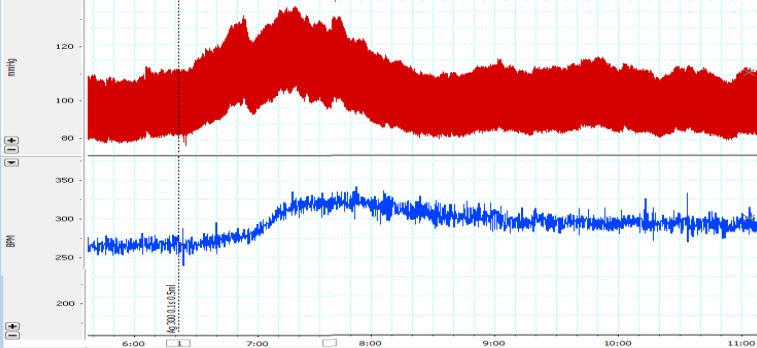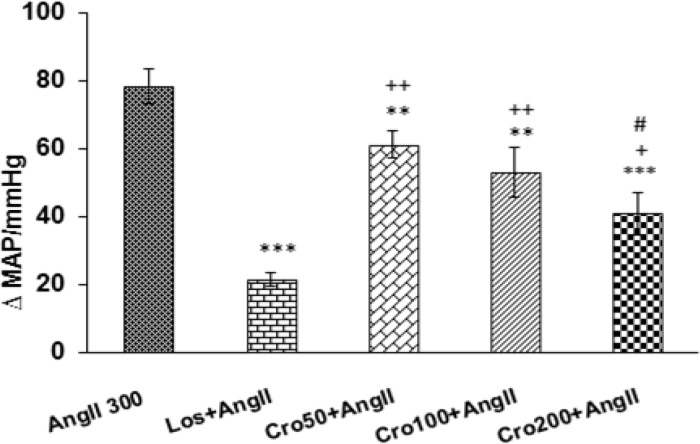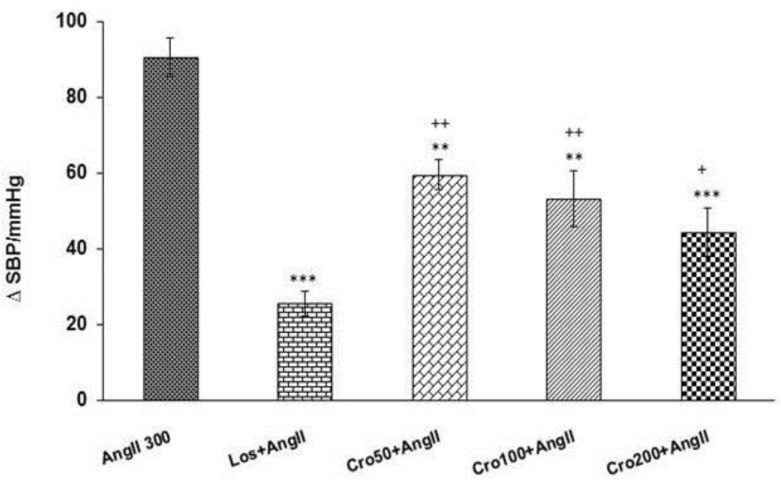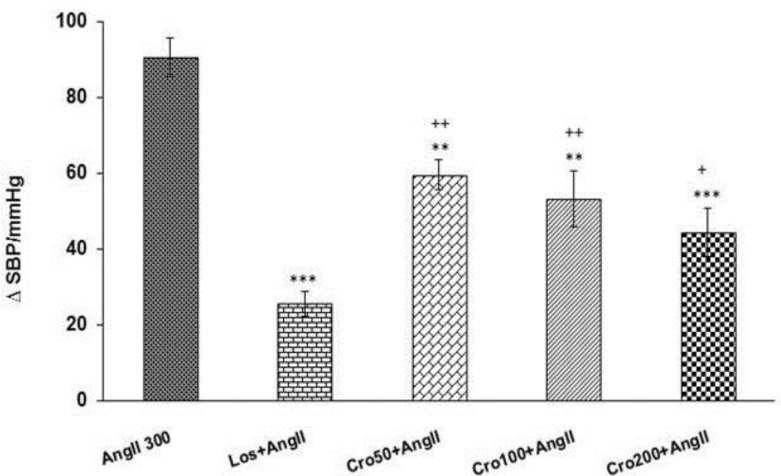Abstract
Objective:
Angiotensin II (Ang II), the main product of renin-angiotensin system (RAS) has a well-known role in cardiovascular regulation. Over-production of Ang II is one of the important underlying mechanisms of hypertension. In this study, the effect of crocin on cardiovascular responses in rats with acute hypertension induced by Ang II was evaluated.
Materials and Methods:
Rats were divided into six groups (n = 6): 1) Control: rats that received saline, 2) Ang II: rats that received Ang II (300 ng/kg) infused in two min, 3) Losartan (Los) + Ang II : rats that received Los (10 mg/kg, i.v) before Ang II, and 4-6) Crocin (Cro) + Ang II groups: rats that received three doses of crocin (50, 100 and 200 mg/kg, slow i.v) 10 min before Ang II. Femoral artery and vein were cannulated for recording of cardiovascular parameters and injection of drugs, respectively. Systolic blood pressure (SBP), mean arterial blood pressure (MAP) and heart rate (HR) were continuously recorded by power lab system. After injection of reagents and extracts, maximum changes (∆) of MAP, SBP and HR were recorded and compared with control group.
Results:
Ang II (300 ng/kg) increased maximal changes in MAP, SBP and HR compared to control group (p<0.001) and Los significantly attenuated these effects of Ang II (p<0.001). Maximal changes of MAP, SBP and HR induced by Ang II, were significantly attenuated by pretreatment with all doses of crocin (50,100 and 200) (p<0.05 and p<0.001). Also, changes of MAP, SBP and HR in Crocin + Ang II groups were significantly different from Los + Ang II group (p<0.05 and p<0. 01).
Conclusion:
Based on the effects of crocin on acute Ang II-induced hypertension, it is hypothesized that the cardiovascular improving effects of crocin may be mediated via suppressing of RAS.
Key Words: Crocin, Hypertension, Heart rate, Mean arterial pressure, Angiotensin II
Introduction
Hypertension is one of the most important cardiovascular risk factors in all over the world. Hypertension can induce health-threatening disorders such as heart diseases, congestive heart failure, stroke, impaired vision and kidney dysfunction (Xie and Zhang, 2012 ▶). Although the exact mechanism(s) of hypertension has remained unknown, several factors such as increased activity of the sympathetic and renin angiotensin system (RAS) as well as disruption of local regulatory mechanisms have been reported to be involve in pathogenesis of this disorder (Veerasingham and Raizada, 2003 ▶).
Renin- angiotensin system (RAS) has been reported to play an important role in cardiovascular regulation (Ibrahim 2006 ▶; Mehta and Griendling, 2007 ▶). The main active product of RAS, angiotensin II (Ang II), has been suggested to exert multiple physiological and pathological effects on cardiovascular system such as vasoconstriction, alteration in arterial baroreflex sensitivity, induction of vascular smooth muscle cell growth, stimulation of proto-oncogene expression, induction of myocardial hypertrophy and ventricular remodeling (Mehta and Griendling 2007 ▶; Rajagopalan et al., 1996 ▶; Taubman et al., 1989 ▶). The cardiovascular effects of Ang II were mostly mediated via AT1 receptor (Mehta and Griendling, 2007 ▶).
Crocus sativus (C. sativus), known as saffron, is a perennial stemless herb that is cultivated in Iran, especially South Khorasan (Srivastava et al., 2010 ▶). C. sativus possesses the dried red stigma with a small portion of the yellowish style attached to it (Hosseinzadeh and Talebzadeh, 2005 ▶). The value of C. sativus is attributed to the existence of three main constituents namely, crocin, picrocrocin, and safranal (Abe and Saito, 2000 ▶). Crocin is a water soluble carotenoid dye which gives food a golden-yellow tint. Based on previous studies, crocin has neuroprotective (Khazdair et al., 2015 ▶), smooth muscle relaxant effect (Mokhtari-Zaer et al., 2015 ▶), anti-tumor, radical scavenging, anti-hyperlipidemic and memory-improving effects (Razavi et al., 2013b ▶). Effect of crocin on blood pressure has been previously shown (Imenshahidi et al., 2010 ▶; Imenshahidi et al., 2014a ▶; Razavi et al., 2013a ▶). It has been reported that crocin dose-dependently attenuates hypertension induced by desoxycorticosterone acetate (DOCA) salt in rats (Imenshahidi et al., 2014b ▶). Crocin also improved cardiovascular toxicity caused by diazinon (DZN) via reducing oxidative stress in rats (Razavi et al., 2013a ▶). Although hypotensive effect of crocin on cardiovascular system has been shown but its exact mechanism is unknown. It seems that hypotensive effects of crocin partly were mediated via RAS inhibition. Therefore, in the present study, the effect of crocin on blood pressure and heart rate in rats with acute hypertension induced by Ang II was evaluated.
Materials and Methods
Experimental animals
Thirty-six male Wistar rats (260±10 g) were kept in a colony room with 12 hr/12 hr light/dark cycle at 21 ± 2°C. The animals were freely allowed to have access to food and water. Animal examinations were carried out in accordance with procedures approved by the Committee on Animal Research of Mashhad University of Medical Sciences (Process Number 900559).
Drugs and reagents
Ang II and urethane (Sigma, USA), losartan (Los, an angiotensin-II receptor blocker; as a gift from Darupaksh, I.R. Iran) and crocin were used. Crocin and losartan were dissolved in saline.
Experimental groups
Rats were randomly grouped (n = 6 in each group) into six groups as follow:
Control group that received saline (intravenous (i.v)).
Ang II group that received Ang II (300 ng/kg, intravenously infused for 2 min).
Los group that received losartan (10 mg/kg, i.v) 2 min before injection of Ang II.
Cro 50+Ang II that received crocin (50 mg/kg, i.v) and Ang II (300 ng/kg, i.v infusion for 2 min) 10 min after injection of crocin.
Cro 100 + Ang II that received crocin (100 mg/kg, i.v) and Ang II (300 ng/kg, i.v infusion for 2 min) 10 min after injection of crocin.
Cro 200 + Ang II that received crocin (200 mg/kg, i.v) and Ang II (300 ng/kg, i.v infusion for 2 min) 10 min after injection of crocin.
All doses were selected based on previous studies (Imenshahidi et al., 2010 ▶; Imenshahidi et al., 2014b ▶; Mahmoudabady et al., 2014 ▶)
Experimental procedure
Acute hypertension was induced by i.v infusion of Ang II according to previous studies (Mahmoudabady et al., 2014 ▶; Perez et al., 2010 ▶). In summary, Ang II (300 ng/kg) was intravenously infused for 2 min to achieve a high and sustained blood pressure (Bruner and Fink, 1985 ▶; Mahmoudabady et al., 2014 ▶). In crocin groups, three doses of crocin were i.v injected 10 min before Ang II. Volume of injection was 0.5 ml. Temperature was kept at 37.5°C, using a heating lamp.
The animals were anesthetized with urethane (1.5 g/kg, i.p. and 0.7 g/kg as supplementary doses). After exposing the femoral artery, a polyethylene catheter- 50 filled with heparinized saline, was inserted in the artery and connected to a pressure transducer. The mean arterial pressure (MAP), systolic blood pressure (SBP) and heart rate (HR) were continuously recorded for 15 min using a power lab system (ID instrument, Australia) (Shafei et al., 2013 ▶). The femoral vain also cannulated for drug injection.
Data analysis
All data were expressed as mean ± SEM. The maximum changes (∆) were obtained and compared with the control group. The data of maximal changes was compared using one way ANOVA followed by Tukey’s post hoc comparisons test. Differences were considered statistically significant when p<0.05.
Results
Effects of injection of saline on cardiovascular responses
Baseline MAP, SBP and HR before injection of saline were recorded; then, saline was administered via the femoral vain. The results showed that administration of saline had no significant effect on MAP (before: 111.12±2.27 mmHg and after: 110.88±1.98 mmHg), SBP (before: 124.22±3.91 mmHg and after: 122.90±3.92 mmHg) and HR (before: 321.80±14.69 beats/min and after: 312.71 ± 15.7 beats/min).
Effects of intravenous infusion of Ang II (300 ng/kg) on cardiovascular responses
In this study, Ang II (300ng/kg, i.v) was administered and cardiovascular responses were evaluated. Figure 1 shows a typical record of blood pressure and heart rate in response to Ang II injection. Maximal changes of SBP, MAP and HR are also shown in Figure 2. As shown in Figure 2, all parameters significantly increased compared to control group (p<0.001).
Figure 1.
A typical record of blood pressure and heart rate in response to systemic infusion of Ang II (300 ng/kg). The vertical lines indicate the injection time
Figure 2.
Maximal changes of systolic blood pressure (SBP) (A), mean arterial pressure (MAP) (B), and heart rate (HR) (C) in response to infusion of angiotensin II (Ang II 300 ng/kg) and Ang II+ Losartan (Los; 10 mg/kg). Data are expressed as mean ± SEM (n= 6 in each group). One way ANOVA with post hoc test used for statistical analysis. *** p<0.001 compared to control group, +++ p<0.001 compared to Ang II 300 group and # p<0.05 and ## p<0.01 compared to control group
Effect of intravenous injection of losartan on the cardiovascular responses in acute hypertension induced by angiotensin II
According to the results of the present study, pretreatment with losartan significantly reduced Ang II-induced MAP and SBP enhancement (p<0.001) (Figure 2). Pretreatment with losartan also diminished tachycardia induced by Ang II (p<0. 001) (Figure 2).
Effect of pretreatment with different doses of crocin on the cardiovascular parameters in acute hypertension induced by angiotensin II
The results of this research revealed that administration of crocin (50 and 100 and 200 mg/kg) before Ang II significantly attenuated the enhancement effects of Ang II on MAP and SBP compared to Ang II group (p<0.01 and p<0.001) (Figures 3 and 4). The results also indicated that MAP and SBP at all doses of crocin were significantly higher than Los+ Ang II group (p<0.05 and p<0.01) (Figures 3 and 4). In addition, MAP at the highest dose (200 mg/kg) of crocin was significantly lower than 50 and 100 mg/kg doses (p<0.05) (Figure 3).
Figure 3.
Maximal changes of mean arterial pressure (MAP) in response to intravenous injection of three doses of crocin (50,100 and 200 mg/kg) + (Ang II 300 ng/kg) compared to Ang II 300 group. Data are presented as mean ± SEM (n = 6 in each group). One way ANOVA with post hoc test used for statistical analysis. ** p<0.01 and *** p<0.001 compared to Ang II 300 group, ++ p<0.05 and ++ p<0.01compared to Los + Ang II group, # p<0.05 compared to Cro 50 + Ang II and Cro100 + Ang II groups.
Figure 4.
Maximal changes of systolic blood pressure (SBP) in response to intravenous injection of three doses of crocin (50,100 and 200 mg/kg) + angiotensin II (Ang II 300 ng/kg) compared to Ang II 300 group. Data are presented as mean ± SEM (n = 6 in each group). One way ANOVA with Toky post hoc test used for statistical analysis. ** p<0.01 and *** p<0.001 compared to Ang II 300 group, + p<0.05 and ++ p<0.01 compared to Los + Ang II group
The results of current study also showed that all three doses of crocin (Cro 50+Ang II, Cro 100 + Ang II and Cro 200+Ang II) reduced changes of HR in comparison with Ang II group (p<0.05 and p<0.01) (Figure 5). In addition, changes of HR in Cro 50 + Ang II and Cro 100 + Ang II was significantly higher than changes in Los + Ang II group (p<0.05), but the in Cro 200 + Ang II group was not significant (Figure 5). There was also no significant different in changes of HR between all Cro + Ang II treated groups (Figure 5).
Figure 5.
Maximal changes of heart rate (HR) in response to intravenous injection of three doses of crocin (50,100 and 200 mg/kg) + angiotensin II (Ang II 300 ng/kg) compared to Ang II 300 group. Data are presented as mean ± SEM (n = 6 in each group). * p<0.05, ** p<0.01 and *** p<0.001 compared to Ang II 300 group as well as + p<0.05 compared to Los + Ang II group
Discussion
The results of the current study showed that Ang II (300 ng/kg) administration significantly enhanced MAP, SBP and HR compared to control group and Los (an AT1 receptor blocker) significantly attenuated the cardiovascular effects of Ang II. In addition, pretreatment with crocin 50, 100 and 200 mg/kg were significantly decreased effects of Ang II on cardiovascular parameters. Moreover, the effects of the highest dose of crocin were comparable with those of losartan.
The Ang II, the main product of RAS, has been reported to play an important role in the cardiovascular system regulation (Mehta and Griendling 2007 ▶; Stegbauer et al., 2009 ▶). The acute effect of Ang II on the cardiovascular system is mostly mediated via vasoconstriction, increased sympathetic tone and arginine vasopressin release (Lavoie and Sigmund, 2003 ▶).
Ang II has been also reported to contribute to the development of hypertension via enhancing the release of catecholamines from the adrenal gland and nerve terminals and increasing salt retention (Crowley et al., 2006 ▶). Previously, researchers have also propounded that Ang II-induced hypertension can take place through cellular events including promotion of phospholipase C and phosphatidylinositol hydrolysis, enhancement of intracellular free calcium concentration, activation of protein kinase C and decreased release of NO (Carey and Siragy 2003 ▶; Touyz 2003 ▶; Touyz and Schiffrin, 2000 ▶). In addition, Ang II has been reported to have a facilitating effect on Ca2+ mobilization from the sarcoplasmic reticulum (Mehta and Griendling, 2007 ▶).
C. sativus and its active compound crocin have been reported to increase vasodilators such as NO (Mancini et al., 2014 ▶). He et al indicated that crocin can suppress Ca2+ release from the endoplasmic reticulum and inhibits influx of extracellular Ca2+ in aortic smooth muscle cells (He et al., 2004 ▶). Boskabady et al also showed that C. sativus exerts an inhibitory effect on calcium channels in pig’s isolated heart that is comparable with the effect of diltiazem on these channel (Boskabady et al., 2008 ▶). Considering these findings, it seems that restoring effect of crocin on Ang II- induced hypertension in current study is mediated through these pathways.
In addition, growing evidence show that Ang II can influence blood pressure via stimulating the production of reactive oxygen species (ROS) and induction of oxidative stress (Laursen et al., 1997 ▶; Zimmerman et al., 2004 ▶). It has been indicated that increased levels of ROS followed by Ang II injection, result in vasoconstriction (Mollnau et al., 2002 ▶). In addition, Antioxidant effect of crocin has been documented (Asdaq and Inamdar 2010 ▶; Hosseinzadeh et al., 2009 ▶; Zheng et al., 2007 ▶). It has been reported that C. sativus and crocin reduce lipid peroxidation and enhance enzymatic and non- enzymatic antioxidant (Zheng et al., 2007 ▶). Therefore, it seems that a part of the improving effects of crocin on Ang II-induced hypertension may be mediated via its antioxidant effects. However, more investigations are needed to elucidate the exact mechanism(s).
Losartan is a selective AT1 receptors antagonist which is demonstrated to induce experimental hypotension in experimental studies (Wong et al., 1990b ▶). Losartan has been reported to lower blood pressure in hypertensive rats (Wong et al., 1990a ▶). It has been suggested that this nonpeptide AT1 receptors antagonist might cause a renin-dependent hypotensive effect in patients with essential hypertension (Tsunoda et al., 1993 ▶). Losartan has been also proposed as an effective drug in regulating blood pressure and long-term renal damage in hypertensive patients (Patten and Abeywardena, 2017 ▶). The results of the present study also showed that administration of losartan before AngII attenuated the effect of Ang II on cardiovascular parameters. Therefore cardiovascular effect of Ang II is mostly mediated via AT1. Because crocin attenuate increased blood pressure and tachycardia induced by Ang II and these effects are comparable with losartan, it is possible that the effect of crocin on cardiovascular responses of Ang II is mediated via AT1 receptor. However, the exact mechanisms of these effects are not determined and needs further studies.
In summary, regarding to modulatory effects of crocin on Ang II-induced hypertension, it seems that the inhibitory effect of crocin on the cardiovascular system was partly mediated via suppression of renin-angiotensin system.
Acknowledgements
The results described in this paper were from a MSC student`s thesis. The authors would like to thank the Vice Presidency of Research of Mashhad University of Medical Sciences for their financial support.
References
- Abe K, Saito H. Effects of saffron extract and its constituent crocin on learning behaviour and long‐term potentiation. Phytother Res. 2000;14:149–152. doi: 10.1002/(sici)1099-1573(200005)14:3<149::aid-ptr665>3.0.co;2-5. [DOI] [PubMed] [Google Scholar]
- Asdaq SMB, Inamdar MN, 2010 Appl biochem biotechnol. Potential of Crocus sativus (saffron) and its constituent, crocin, as hypolipidemic and antioxidant in rats;162:358–372. doi: 10.1007/s12010-009-8740-7. [DOI] [PubMed] [Google Scholar]
- Boskabady M, Shafei M, Shakiba A, Sefidi HS. Effect of aqueous‐ethanol extract from Crocus sativus (saffron) on guinea‐pig isolated heart. Phytother Res. 2008;22:330–334. doi: 10.1002/ptr.2317. [DOI] [PubMed] [Google Scholar]
- Bruner CA, Fink GD. Cerebroventricular infusion of angiotensin antagonist does not influence hypertensive response to blood-borne angiotensin II. Brain Res. 1985;360:15–23. doi: 10.1016/0006-8993(85)91215-6. [DOI] [PubMed] [Google Scholar]
- Carey RM, Siragy HM. Newly recognized components of the renin-angiotensin system: potential roles in cardiovascular and renal regulation. Endocr Rev. 2003;24:261–271. doi: 10.1210/er.2003-0001. [DOI] [PubMed] [Google Scholar]
- Crowley SD, Gurley SB, Herrera MJ, et al. Angiotensin II causes hypertension and cardiac hypertrophy through its receptors in the kidney. Proc Nati Acad Sci. 2006;103:17985–17990. doi: 10.1073/pnas.0605545103. [DOI] [PMC free article] [PubMed] [Google Scholar]
- He S-Y, Qian Z-Y, Tang F-T. Effect of crocin on intracellular calcium concentration in cultured bovine aortic smooth muscle cells. Yao xue xue bao. 2004;39:778–781. [PubMed] [Google Scholar]
- Hosseinzadeh H, Shamsaie F, Mehri S. Antioxidant activity of aqueous and ethanolic extracts of Crocus sativus L stigma and its bioactive constituents, crocin and safranal. Pharmacog Mag. 2009;5:419. [Google Scholar]
- Hosseinzadeh H, Talebzadeh F. Anticonvulsant evaluation of safranal and crocin from Crocus sativus in mice. Fitoterapia. 2005;76:722–724. doi: 10.1016/j.fitote.2005.07.008. [DOI] [PubMed] [Google Scholar]
- Ibrahim MM. RAS inhibition in hypertension. J Hum Hhypertens. 2006;20:101–108. doi: 10.1038/sj.jhh.1001960. [DOI] [PubMed] [Google Scholar]
- Imenshahidi M, Hosseinzadeh H, Javadpour Y. Hypotensive effect of aqueous saffron extract (Crocus sativus L.) and its constituents, safranal and crocin, in normotensive and hypertensive rats. Phytother Res. 2010;24:990–994. doi: 10.1002/ptr.3044. [DOI] [PubMed] [Google Scholar]
- Imenshahidi M, Razavi BM, Faal A, Gholampoor A, Mousavi SM, Hosseinzadeh H. Effects of chronic crocin treatment on desoxycorticosterone acetate (doca)-salt hypertensive rats. Iran J Basic Med Sci. 2014a;17:9–13. [PMC free article] [PubMed] [Google Scholar]
- Imenshahidi M, Razavi BM, Faal A, Gholampoor A, Mousavi SM, Hosseinzadeh H. Effects of chronic crocin treatment on desoxycorticosterone acetate (doca)-salt hypertensive rats. Iran J Basic Med Sci. 2014b;17:9–13. [PMC free article] [PubMed] [Google Scholar]
- Khazdair MR, Boskabady MH, Hosseini M, Rezaee R, Tsatsakis AM. The effects of Crocus sativus (saffron) and its constituents on nervous system: A review. Avicenna J Phytomed. 2015;5:376–391. [PMC free article] [PubMed] [Google Scholar]
- Laursen JB, Rajagopalan S, Galis Z, Tarpey M, Freeman BA, Harrison DG. Role of superoxide in angiotensin II–induced but not catecholamine-induced hypertension. Circulation. 1997;95:588–593. doi: 10.1161/01.cir.95.3.588. [DOI] [PubMed] [Google Scholar]
- Lavoie JL, Sigmund CD. Minireview: overview of the renin-angiotensin system—an endocrine and paracrine system. Endocrinology. 2003;144:2179–2183. doi: 10.1210/en.2003-0150. [DOI] [PubMed] [Google Scholar]
- Mahmoudabady M, Shafei MN, Niazmand S, Khodaee The effects of hydroalchoholic extract of Teucrium polium L on hypertension induced by angiotensin II in rats. Int J Prev Med. 2014;5:1255. [PMC free article] [PubMed] [Google Scholar]
- Mancini A, Serrano-Díaz J, Nava E, et al. Crocetin, a carotenoid derived from saffron (Crocus sativus L) improves acetylcholine-induced vascular relaxation in hypertension. J Vasc Res. 2014;51:393–404. doi: 10.1159/000368930. [DOI] [PubMed] [Google Scholar]
- Mehta PK, Griendling KK. Angiotensin II cell signaling: physiological and pathological effects in the cardiovascular system. Am J Physiol Cell Physiol. 2007;292:C82–C97. doi: 10.1152/ajpcell.00287.2006. [DOI] [PubMed] [Google Scholar]
- Mokhtari-Zaer A, Khazdair MR, Boskabady MH. Smooth muscle relaxant activity of Crocus sativus (saffron) and its constituents: possible mechanisms. Avicenna J Phytomed. 2015;5:365–375. [PMC free article] [PubMed] [Google Scholar]
- Mollnau H, Wendt M, Szöcs K, et al. Effects of angiotensin II infusion on the expression and function of NAD (P) H oxidase and components of nitric oxide/cGMP signaling. Circ Res. 2002;90:e58–e65. doi: 10.1161/01.res.0000012569.55432.02. [DOI] [PubMed] [Google Scholar]
- Patten GS, Abeywardena MY. Effects of Antihypertensive Agents on Intestinal Contractility in the Spontaneously Hypertensive Rat: Angiotensin Receptor System Downregulation by Losartan. J Pharmacol Exp Ther. 2017;360:260–266. doi: 10.1124/jpet.116.237586. [DOI] [PMC free article] [PubMed] [Google Scholar]
- Perez YY, Jimenez-Ferrer E, Alonso D, Botello-Amaro CA, Zamilpa A. Citrus limetta leaves extract antagonizes the hypertensive effect of angiotensin II. J ethnopharmacol. 2010;128:611–614. doi: 10.1016/j.jep.2010.01.059. [DOI] [PubMed] [Google Scholar]
- Rajagopalan S, Kurz S, Münzel T, et al. Angiotensin II-mediated hypertension in the rat increases vascular superoxide production via membrane NADH/NADPH oxidase activation Contribution to alterations of vasomotor tone. J Clin Invest. 1996;97:1916. doi: 10.1172/JCI118623. [DOI] [PMC free article] [PubMed] [Google Scholar]
- Razavi BM, Hosseinzadeh H, Movassaghi AR, Imenshahidi M, Abnous K. Protective effect of crocin on diazinon induced cardiotoxicity in rats in subchronic exposure. Chem Biol Interac. 2013a;203:547–555. doi: 10.1016/j.cbi.2013.03.010. [DOI] [PubMed] [Google Scholar]
- Razavi M, Hosseinzadeh H, Abnous K, Motamedshariaty VS, Imenshahidi M. Crocin restores hypotensive effect of subchronic administration of diazinon in rats. Iran J Basic Med Sci. 2013b;16 [PMC free article] [PubMed] [Google Scholar]
- Shafei MN, Niazmand S, Hosseini M, Daloee MH. Pharmacological study of cholinergic system on cardiovascular regulation in the cuneiform nucleus of rat. Neurosci lett. 2013;549:12–17. doi: 10.1016/j.neulet.2013.05.046. [DOI] [PubMed] [Google Scholar]
- Srivastava R, Ahmed H, Dixit R. Crocus sativus L.: a comprehensive review. Pharmacogn Rev. 2010;4:200. doi: 10.4103/0973-7847.70919. [DOI] [PMC free article] [PubMed] [Google Scholar]
- Stegbauer J, Lee D-H, Seubert S, et al. Role of the renin-angiotensin system in autoimmune inflammation of the central nervous system. Proc Nati Acad Sci. 2009;106:14942–14947. doi: 10.1073/pnas.0903602106. [DOI] [PMC free article] [PubMed] [Google Scholar]
- Taubman MB, Berk BC, Izumo S, Tsuda T, Alexander RW, Nadal-Ginard B. Angiotensin II induces c-fos mRNA in aortic smooth muscle Role of Ca2+ mobilization and protein kinase C activation. J Biol Chem. 1989;264:526–530. [PubMed] [Google Scholar]
- Touyz RM. Recent advances in intracellular signalling in hypertension. Curr Opin Nephrol Hypertens. 2003;12:165–174. doi: 10.1097/00041552-200303000-00007. [DOI] [PubMed] [Google Scholar]
- Touyz RM, Schiffrin EL. Signal transduction mechanisms mediating the physiological and pathophysiological actions of angiotensin II in vascular smooth muscle cells. Pharmacol Rev. 2000;52:639–672. [PubMed] [Google Scholar]
- Tsunoda K, Abe K, Hagino T, et al. Hypotensive effect of losartan, a nonpeptide angiotensin II receptor antagonist, in essential hypertension. Am J Hypertens. 1993;6:28–32. doi: 10.1093/ajh/6.1.28. [DOI] [PubMed] [Google Scholar]
- Veerasingham SJ, Raizada MK. Brain renin–angiotensin system dysfunction in hypertension: recent advances and perspectives. Br J pharmacol. 2003;139:191–202. doi: 10.1038/sj.bjp.0705262. [DOI] [PMC free article] [PubMed] [Google Scholar]
- Wong PC, Price W, Chiu AT, et al. Nonpeptide angiotensin II receptor antagonists XI Pharmacology of EXP3174: an active metabolite of DuP 753, an orally active antihypertensive agent. J Pharmacol Exp Ther. 1990a;255:211–217. [PubMed] [Google Scholar]
- Wong PC, Price WA, Chiu AT, et al. Nonpeptide angiotensin II receptor antagonists Studies with EXP9270 and DuP 753. Hypertension. 1990b;15:823–834. doi: 10.1161/01.hyp.15.6.823. [DOI] [PubMed] [Google Scholar]
- Xie Y, Zhang W. Antihypertensive activity of Rosa rugosa Thunb flowers: angiotensin I converting enzyme inhibitor. J Ethnopharmacol. 2012;144:562–6. doi: 10.1016/j.jep.2012.09.038. [DOI] [PubMed] [Google Scholar]
- Zheng Y-Q, Liu J-X, Wang J-N, Xu L. Brain Res. 2007 Effects of crocin on reperfusion-induced oxidative/nitrative injury to cerebral microvessels after global cerebral ischemia;1138:86–94. doi: 10.1016/j.brainres.2006.12.064. [DOI] [PubMed] [Google Scholar]
- Zimmerman MC, Lazartigues E, Sharma RV, Davisson RL. Hypertension caused by angiotensin II infusion involves increased superoxide production in the central nervous system. Circ Res. 2004;95:210–216. doi: 10.1161/01.RES.0000135483.12297.e4. [DOI] [PubMed] [Google Scholar]







